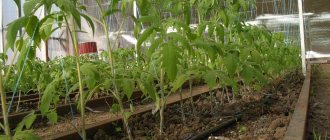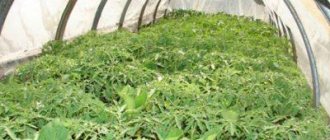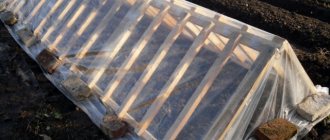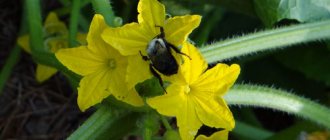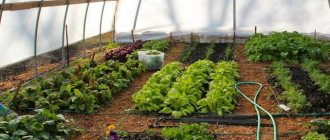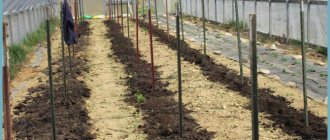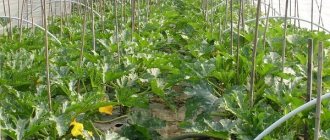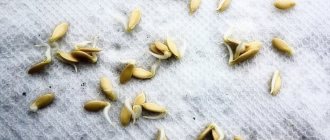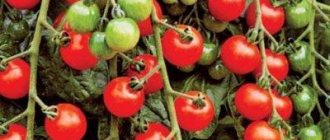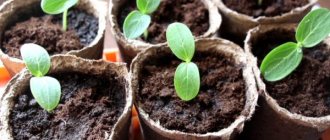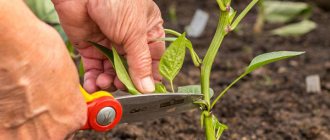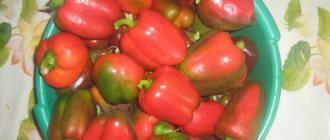Experienced gardeners know that growing peppers in most regions of our country, even in protected soil conditions, is not an easy task. The correct choice of pepper varieties for the greenhouse, which have different properties and characteristics, is important.
Today, a huge number of hybrid and varietal varieties of crops have been bred for cultivation in greenhouse conditions.
We grow healthy and strong seedlings
It is better to start sowing peppers in mid-February. To grow seedlings separately, use purchased soil such as “Malyshok” or “Living Earth”. And then do everything according to the instructions:
- Step 1. Pour soil into containers at a height of 6-7 cm, make shallow grooves, and opposite make small signs with the names of the varieties.
- Step 2. Water the furrows with boiling water and begin sowing. To do this, make a distance of up to 2 cm in the rows between the seeds, and 4-5 cm between the rows themselves.
- Step 3. Moisten the spread seeds with water from a spray bottle and sprinkle 1 cm of soil. Spray the soil again and cover the container with a lid.
- Step 4. Place the container on the battery for 2-3 hours.
- Step 5. Now we move it to a warm place (26-28°C) and wait for the first shoots.
As soon as the first shoots appear, we move the container with the plants to the windowsill or to the greenhouse vestibule. It is now advisable to also use special supplementary lighting - phytolamps. Maintain a distance of about 15 cm from the lamp to the seedlings, and turn it on from 8.00 to 23.00. During the day, the air temperature near the seedlings should be within 20-22°C, and at night – 18-20°C.
During this period, beware of a common disease of pepper seedlings - black leg. Just follow these rules: do not over-moisten the soil, at the first shoots immediately transfer the seedlings to the sun, and on the same day reduce the temperature from 28°C to 20°C. And as the plants grow, water them between the rows. Water the peppers as the soil dries out.
To avoid getting elongated and pale seedlings, make sure that there is not enough light in the heat. After all, it is precisely because of this that plants stretch out - to increase their own skin area, which traps ultraviolet rays. Therefore, if the air near your seedlings reaches 25°C, then the illumination should be maximum, and you cannot do without special additional lighting.
But if there is none, then urgently lower the temperature to 18-20°C, which, of course, will slow down the growth of seedlings, but will not allow it to become pale and long, like spider legs. Although the pepper seedlings themselves, unlike tomato seedlings, are not too prone to stretching, and yet.
As soon as the seedlings grow, they will need to be pruned. An hour before this process, water the plants. For picking, use a teaspoon, carefully separating a row of peppers of the same type with the flat side. Try to injure the roots as little as possible.
Pour soil into a new container so that it is a little less than half, and lower the plant there. Next, fill the sides with soil up to the cotyledons, slightly squeezing the trunk. Now also water around the edges of the container, but for the first couple of days do not give water at all - this will allow the peppers to develop a good root system.
And the root system is best developed in seedlings grown in 500-gram seedling pots and in peat tablets:
Popular varieties: brief descriptions with photos
Let's consider the most common varieties and hybrids of sweet peppers intended for cultivation in greenhouses in all regions:
“Antey F1” An early-ripening large-fruited hybrid of Israeli origin, included in the State Register of the Russian Federation in 2022. Recommended for gardening cultivation in protected soil. The plant is medium-sized, semi-standard. The fruits are cube-shaped, weighing 215-220 g. In the phase of technical ripeness they are green in color, in the biological stage they are red with a strong glossy shine. They have a sweet taste and pronounced aroma, perfect for canning and home cooking. The yield in the greenhouse is about 8 kg per square meter.
Packaging of seeds and pepper bush "Antey F1", bearing fruit in protected soil conditions
“Bucharest” A mid-early variety of domestic selection, included in the State Register of the Russian Federation in 2008. The plant is semi-spreading, medium-sized. The fruits are cone-shaped, weighing about 150 g. In the phase of technical ripeness they are purple in color, in the biological stage they are red with a pronounced glossy shine. They have a pleasant taste and a light classic aroma. Thick-walled, ideal for home cooking, canning and freezing. Productivity reaches 4.2 kg/m².
Seeds in agro packaging) and a Bucharest pepper bush with fruits that have reached technical ripeness
“Vesper” An early ripening variety, registered in the State Register since 1999, intended for gardening throughout the Russian Federation in protected soil conditions. The period from full germination to technical ripeness is 108 days. The bushes are semi-spreading, slightly leafy, 80-120 cm high. The pods are elongated-cone-shaped, with a sharp apex, slightly wavy, weighing 60-90 g. By the time of harvest they are yellowish in color, in biological ripeness they are dark red with a pronounced glossy sheen. The taste is sweet, with a strong aroma. Intended for home cooking and fresh consumption. Commercial yield is 5-7 kg/m². The plant sets fruit well at low temperatures.
Packaging of seeds from the originator (Federal Scientific Center for Vegetable Growing) and fruit harvest at the stage of biological maturity
“Greta F1” Belongs to the group of mid-season hybrids of foreign (English) selection, included in the State Register in 2018. The plant is semi-spreading, medium-sized. The fruits are cuboidal, drooping, of medium length, weighing about 150 g, walls 7-8 mm thick. The color at technical ripeness is dark green, at biological ripeness it is red. The flavor develops well when canned. Productivity under film covers is up to 5.9 kg/m².
Packaging of seeds and bush “Greta F1” during the period of active fruiting
"Davos F1" Mid-early hybrid of Dutch origin, included in the State Register in 2022. Recommended for cultivation in the Northern region and areas of the 1st light zone of the Russian Federation in heated and film greenhouses in winter-spring and extended rotation as a soil and low-volume crop. The plant is medium-sized. The fruits are drooping, cube-shaped, weighing 212-242 g, wall thickness 6-7 mm. When biological ripeness is reached, the color becomes dark red, while in technical ripeness it turns green. They are distinguished by a sweet taste, which is revealed to the maximum in salads. Productivity in protected soil conditions is about 8.2-9.2 kg/m² (above the Nagano F1 and Stayer F1 standards). The yield of marketable products reaches more than 98% of the harvest.
From the emergence of seedlings to the first harvest of pepper at the stage of technical ripeness, 101-114 days pass
"Dakar F1" A mid-season hybrid bred by French specialists, included in the State Register of the Russian Federation in 2008. The plant is small (45-60 cm high), semi-spreading. The fruits are large, weighing about 210 g, with walls up to 8 mm thick, and have a cuboid shape. The color in the phase of technical ripeness is green, in the biological stage it is yellow. The taste is excellent with a strong peppery aroma. Fruits of universal use: used for canning, in home cooking and for fresh consumption. Productivity is about 4.5 kg/m². The plant is resistant to a dangerous viral disease - tobacco mosaic.
Fully ripened fruits of the hybrid pepper "Dakar F1"
“Dionysus” A mid-early variety included in the State Register in 2011, bred by breeders of the Leningrad Scientific Research Institute of Agriculture “Belogorka”, recommended for cultivation throughout Russia. The plant is semi-spreading, of medium height. The fruits, hanging down, are prism-shaped, smooth, weighing 90-100 g. At first they are colored green, when fully ripe they become yellow with a glossy sheen. Wall thickness 4-6 mm. The taste is good: sweet and juicy. It is used mainly fresh. Productivity is about 5-6 kg/m².
The pods of “Dionysus” removed from the bush reach biological ripeness during the process of “ripening”
“Dolly F1” Mid-season hybrid of English selection, included in the State Register in 2011. Well suited for gardening in all regions of Russia in closed ground conditions. The bush is semi-spreading, medium-sized. The fruits are triangular in shape, weigh on average 150-170 g, wall thickness is 5-6 mm, and are used for canning and fresh. The color is dark green at the time of technical ripeness and bright red with a glossy sheen at the stage of full ripening. The taste is sweet with a classic aroma. Productivity is about 5 kg/m². The plant is resistant to TMV.
“Dolly F1” is deservedly in high demand among vegetable growers, as it has excellent commercial and consumer qualities
“Eroshka” An early ripening variety, created by breeding and seed production, has been listed in the State Register since 2003. The bush is compact, low-growing, closed. The fruits droop downwards, are cuboid in shape, weighing 140-180 g, walls 5-6 mm thick. The color is light green and then red with a glossy sheen when fully ripe. The taste of the fruit is good: sweet and juicy. Productivity is about 4.8 kg/m². The variety is valued for its uniform harvest ripening, large fruit, meatiness and good taste.
Seeds in the packaging of the originating agricultural company and a compact bush “Eroshki” with ripened fruits
“Yellow Bull NK F1” A mid-early domestic hybrid of the first generation, included in the State Register in 2001, recommended for cultivation in the Central region. From the emergence of seedlings to the first harvest at the stage of technical ripeness, 95-108 days pass. The plant is tall, semi-spreading. The pods are drooping, prism-shaped, smooth, wavy, ribbed, with a deeply depressed stalk, weighing about 200 g, wall thickness 6.8-8.5 mm. In the phase of technical ripeness they are green in color, in biological ripeness they are yellow. They have good taste with a weak aroma. The taste is revealed to its maximum during canning. Productivity under film covers is about 14-20.5 kg/m² (1.4-3.4 kg/m² higher than the “Pluto F1” standard). The yield of marketable products averages 95-99%. Resistant to tobacco mosaic virus. The variety is valued for its high yield, large fruit size, thickness and high taste.
Packaging of seeds and bush of "Yellow Bull NK" during the period of fruit ripening
“Ivolga” An early ripening variety, included in the State Register in 2000, intended for cultivation, primarily in the Northern and Volga-Vyatka regions. From the emergence of seedlings to the first harvest at the stage of technical ripeness, 78-104 days pass. Main advantages: the ability to set fruit in low light and temperature conditions, stable yield, rapid ripening and high marketability of peppers. The plant is standard, medium-sized, semi-spreading. The pods are directed upward, heart-shaped, with a sharp apex, slightly wavy, smooth, with a depressed stalk, weighing from 64 to 85 g, the wall is 4-7 mm thick. The color in the phase of technical ripeness is green, in the biological stage it is yellow. The taste is excellent with a faint peppery aroma. The fruits are used for all types of processing. The maximum yield indicators are 14.5 kg/m² with a commercial product yield of 97-98%.
Seeds in packages from various manufacturers positioning the variety as best suited for the harsh conditions of the Urals and Siberia
"Isabella F1" Mid-season hybrid of domestic selection, registered in the State Register of the Russian Federation since 2003. The plant is standard, closed, tall. The fruits are drooping, prismatic, smooth, weighing 100-120 g, used for fresh consumption, canning and home cooking. In the phase of technical maturity the color is yellowish, in biological maturity it is red. The taste is sweet, with a strong peppery aroma. From the emergence of seedlings to the harvest of the first harvest, 120 days pass. Productivity – 5.6-6.4 kg/m². The main advantages: large fruit, fleshiness and good taste of the fruit, suitable for all types of processing.
Packaging of hybrid seeds and a bush with pods that have reached biological ripeness
“San Siro F1” An early ripening hybrid bred in the Netherlands, included in the State Register of the Russian Federation in 2022. Recommended for gardening cultivation in protected soil throughout the country. The plant is semi-standard, medium-sized, closed. The fruits are drooping, cube-shaped, weighing 220 g. The color in technical ripeness is green, in biological ripeness it is yellow, with a glossy sheen. It has a sweet taste with a classic aftertaste and aroma. Productivity (in film greenhouses) averages 3.1 kg/m2. It is considered resistant to waterlogging, unpretentious and productive.
"San Siro F1" is widely used in cooking: it is perfect for preparing fresh salads and hot dishes, sauces and juices, stuffing, canning, freezing, etc.
Preparing greenhouse beds for peppers
Because Greenhouse pepper is quite weak in terms of various diseases and pests; it is better to disinfect the soil for the beds in advance, and at the same time – the weed seeds. And prepare it correctly, in compliance with all the rules.
Disinfecting soil for garden beds
Here's what to do:
- Step 1. Defrost the soil and warm it to room temperature.
- Step 2. Remove all the baking sheets from the oven, place a grill rack on the bottom of the oven, and a bucket of soil covered with a lid on top.
- Step 3. Turn on the oven at 90°C. Overnight, all living things in the soil will die, but the organic matter will remain.
- Step 4. In the morning, turn off the oven and open the cabinet door.
If plants in your greenhouse often get sick, also water the holes themselves before planting pepper seedlings with a pink solution of potassium permanganate.
And if the situation with diseases and pests is completely deplorable, then use the modern hydroponics method to grow peppers in a greenhouse:
Adjusting the pH level
But what peppers don’t like is acidic soil - be sure to check the pH before planting, because greenhouse soil can change greatly over the years. A typical situation: they took one substrate, checked it, the peppers grew and pleased the harvest for several years, and then - that’s it - they don’t grow and get sick.
And many people don’t even imagine what this could be connected with, because the varieties are the same, and the agricultural technology is unchanged, but in reality it’s such a subtlety. If you suspect that your soil has become acidic, apply dolomite flour as a fertilizer.
Fertilize with useful microelements
Additionally, add complex fertilizers to such beds - nitroammofoska or nitrophoska, or Kemira. If you are a supporter of natural fertilizers, then use rotted manure - the No. 1 fertilizer for peppers, which are especially responsive to organic matter.
It is only important to distribute the fertilizer as evenly as possible over the surface of the earth and then carefully mix the soil with fertilizers and dolomite flour. But, if the stored organic matter for all this turned out to be not enough, then you can safely add it directly to the holes.
In addition, organic matter for pepper is good because it saturates the soil with useful active bacteria, which release carbon dioxide into the air, which in turn is very important. Ordinary wood ash is also ideal for pepper as a fertilizer.
If your greenhouse peppers were not sick last year, then you can take compost from warm beds after harvesting as fertilizer for planting seedlings in the new season. And an excellent fertilizer.
Warming the soil before planting
Loosen the soil in the beds well and water with hot water. This way you can at least somehow imitate soil from the humid American tropics that is close to the nature of pepper. And, once in their native places, the pepper will begin to grow actively, and the hotter it is, the more active the stem will be forced.
Separately for the peppers, you can prepare a warm bed by laying manure or dry grass to a depth of 20-30 cm in the beds. And in addition, so that the peppers do not fry during the day and do not get cold at night, you can bury the following unusual heat accumulators in the ground:
Care after disembarkation
Watering and loosening
To get a rich harvest of peppers, you need to provide them with timely moisture. Young plants need water constantly in small quantities.
Important! It is important not to over-water it, otherwise the plant will get sick and die. If there is a lack of moisture, the pepper will dry out and also die.
The plants are watered for the first time when planting. Next - when the soil at the roots dries. On average, peppers are watered 2-3 times a week. In this case, it is necessary to use settled water at room temperature.
Important! You cannot water with cold water from wells, as this is thermal stress for plants. At the same time, they stop developing.
Also, after watering, it is necessary to loosen the soil to improve its breathability. This is necessary for good growth and fruiting of plants. It is necessary to loosen not deeply, so as not to harm the bushes.
Fertilizer
Plants can be fertilized for the first time 14 days after they are transplanted to their permanent place of growth.
With proper preparation of the site, beds and holes, as well as regular watering and good weather, the peppers will have enough nutrients from the soil. However, you can add stimulants and growth regulators - Humate, Kornevin, Epin, Zircon, etc. They accelerate the adaptation of plants and their survival rate, and also increase the fruiting of adult plants.
Watch the video! Proper planting of pepper seedlings
Marking out pepper plantings: two rows or three?
To plant peppers in a greenhouse, make the following beds: width 80 cm, and row spacing - 30-40 cm. You can plant peppers in two or three rows - as long as it is convenient for you.
In general, how far apart from each other and according to what pattern to plant peppers in a greenhouse directly depends on whether the bushes will be short or tall. Thus, it is better to plant the “Winnie the Pooh” variety closer to the walls of the structure, where there is more light and taller varieties cannot be blocked from the sun’s rays. But plant such medium-growing ones as “Loyalty”, “Medal” and “Tenderness” right behind the short ones. And only closer to the middle - tall ones.
When planting only tall varieties, we make the bed in two rows - so that there is 40-50 cm between the plants. Moreover, try to dig the holes themselves deeper, because Such lumps will need a lot of nutrition, and therefore the root will grow large. Also increase the amount of compost and rotted manure - 1/3 of a bucket per hole.
For medium-growing varieties, make two rows. And finally, if you are planting only low-growing, early-ripening varieties, then make three rows with a spacing of 20-25 cm.
It’s even easier to regulate the distance between plants if you plant them not in beds, but in pots:
We create comfortable conditions
The most convenient way to shade and protect planted pepper seedlings in a greenhouse is with modern covering materials. Moreover, mini-arcs are not necessary under them - the materials are so light that they will not damage delicate plants. Just throw on the same lutrasil or spunbond like a shawl.
Modern covering material for beds will also warm the soil on cold nights:
You can feed the planted seedlings with both organic and mineral fertilizers:
- Organic: Soak 1 part mullein in 4 parts water for a week, then add another 4 parts, mix and add to the planted peppers.
- Mineral: for ten liters of water we take 10 g of ammonium nitrate, 10 g of potassium sulfate, 20 g of calcium nitrate and 30 g of double superphosphate.
Alternate such feedings every 10-15 days, and in the end you will get a wonderful harvest!
